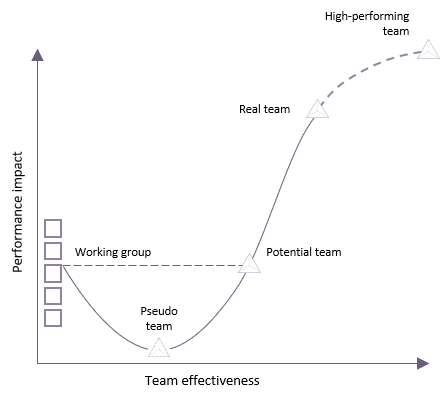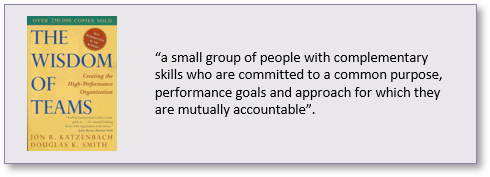This encyclopaedia entry is particularly relevant to the teamwork and leadership topics in the Praxis Framework. See also: |
In the 1993 book ‘The Wisdom of Teams1, Jon Katzenbach and Douglas Smith define a team as:
The book contains two important models. The first relates to ‘team basics’, which must be applied rigorously to overcome the barriers that prevent the relationships required in what they term a ‘real team’.
The team basics are shown as a triangle in which the vertices indicate the things that teams deliver.

The sides of the triangle and the three internal triangles describe the elements and behaviours that enable the deliverables. For example; having a common approach and meaningful goals encourage commitment in the team members and that commitment, in turn, supports the collective work products and personal growth.
A later quotation from Jon Katzenbach explains how he believes that acting on these behaviours is far more important to improving the performance of the team than team-building.

Developing team performance is therefore dependent upon the project manager, programme manager or team leader enabling six key factors:
- Small enough in number
-
Teams need to convene and communicate easily and frequently. They should have open and interactive discussions. If more people are needed to complete the work, sub-teams could be considered rather than make the team unwieldy.
- Adequate levels of complementary skills
-
All three categories of skill need to be represented – there are parallels here with models such as Belbin and Margerison-McCann. The members of the team, individually and collectively, should be willing to develop the required skills in themselves and others.
- Truly meaningful purposeClick here for blogs and articles on teamwork
-
A project or programme’s purpose should be articulated in a document such as the Vision or Business Case. A team should understand and be able to articulate that purpose in the same way. They should frequently refer to it, define it vigorously with stakeholders and explore its implications. It is important to make the purpose meaningful and memorable, and reinforce its importance to the organisation or customer.
- Specific goal or goals
-
Team members should articulate the goals in the same way, they should understand relative priorities and, ultimately, agree that they are the right goals. Goals should clear, simple and measurable (SMART) and generate a clear set of team work-products.
- Clear working approach
-
The work required to achieve the goals should also be clear and collectively understood. The approach must be consistent in its demands on the team members and must accommodate modification and improvement over time.
- Sense of mutual accountability
-
The team should feel a sense of individual and collective accountability for the project and programme’s purpose and the goals, approach and work-products that form their part of it. Progress should be measured against specific goals and individuals should be clear on individual and joint responsibilities. There should be a sense that ‘only the team can fail’.
The second model is the ‘Team performance curve’, as shown below:

- Working group
-
The curve starts with a working group. This is not a team; it is a group of individuals whose outputs rely on the sum of “individual bests”. They don’t pursue collective outputs that require joint effort. Members of a working group interact primarily to share information and practices that enable them to act within their own sphere of responsibility.
- Pseudo team
-
The path to being a team rather than a working group often starts with conflict (see also Tuckman’s ‘storming’ stage of team development) and if the team gets stuck in this stage, it can become what Katzenbach and Smith call a ‘Pseudo team’.
-
Getting stuck in this stage comes as a result of abandoning the discipline of the team basics. This is where Katzenbach’s quote about behaviours and actions apply. Only performance can save a Pseudo team.
-
Pseudo teams are at the lowest point on the performance impact scale, because their individual efforts are not delivering any joint benefit. The project, programme or team manager needs to get the team through this phase by focusing on the goals, work- products and how team members can individually and collectively contribute.
- Potential team
-
As the name suggests, this team has potential. It is moving in the right direction but hasn’t yet established collective accountability. The team will need more clarity on purpose, goals, work-products and a common working approach. A potential team is becoming effective and is making its way up the performance axis but as Katzenbach and Smith say “We believe the steepest performance gain comes between a potential team and a real team.”
- Real team
-
This is the heart of the model. It is the team where a small number of people with complementary skills are equally committed and hold themselves mutually accountable for a common purpose, goals and working approach. This is the minimum level that a project, programme or team leader needs to attain to ensure a successful outcome.
- High performance team
-
Performance impact does not stop with the real team. In some cases, it is reasonable to aim for a high performing team where members are deeply committed to one another’s personal development and success. But we must be realistic and accept that project and programme teams are transitory. They do not necessarily exist for long enough to achieve this level of performance and are always subject to personnel changes.
The content of ‘The Wisdom of Teams’ was developed from extensive first hand observation by the authors of how teams work in many organisations. The principles they established were practical and drawn from real experience (not specifically in project and programme teams, but all teams). A list of the teams observed is actually contained in an Appendix of the book.
The principles are applicable to all contexts. In the project and programme environment, that means it doesn’t matter whether the context is simple or complex, highly agile or more predictive, the same principles still apply.
- Katzenbach, J. R. and Smith, D.K. (1993), The Wisdom of Teams: Creating the High-performance Organisation, Harvard Business School, Boston.
A free e-book containing the entire text is available here: https://epdf.pub/the-wisdom-of-teams-creating-the-high-performance-organization.html







